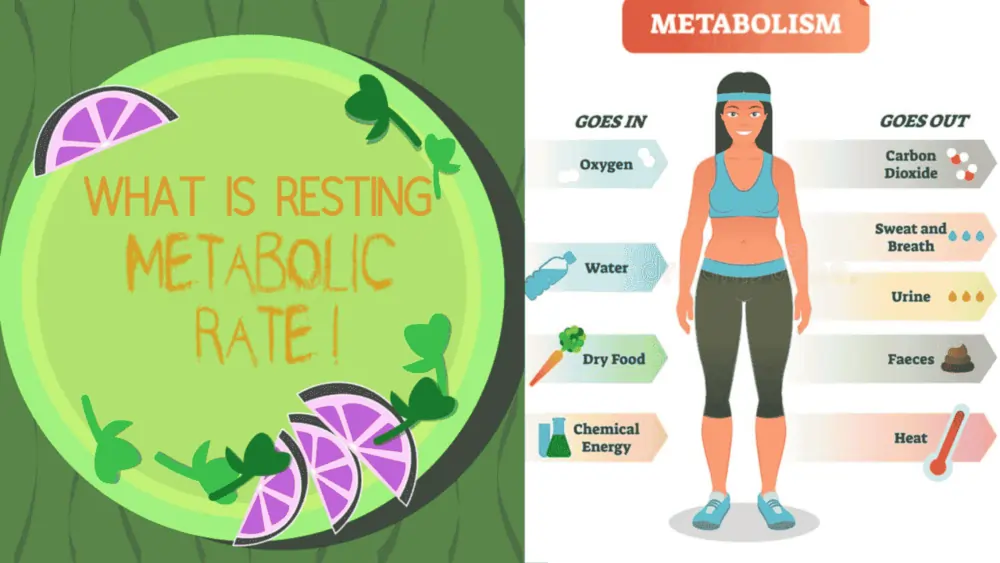Resting Metabolic Rate (RMR)
The resting metabolic rate, or RMR, is what kind of energy (calories) your body requires to maintain important bodily functions while at rest. These include respiration, blood circulation, body temperature regulation, and brain activity support. RMR is frequently used as a starting point for calculating daily calorie requirements.
Resting Metabolic Rate: What Is It?
Resting Metabolic Rate is the metabolism of complete humans (and other vertebrates) under rigorous, stable resting conditions characterized by a confluence of biological equilibrium and physiological homeostasis presumptions.
In contrast to basal metabolic rate (BMR), which must be measured in complete physiological equilibrium, RMR’s measurement circumstances are flexible and can be set by contextual constraints. Therefore, searching for the “perfect” steady state is used to measure BMR. The bulk of daily energy expenditure measurements or calculations, however, are RMR measures since they are simpler to collect.
Your resting metabolic rate is an indicator of how much power the human body requires for daily functioning while you’re sleeping. Alongside basic biological functions, RMR takes into consideration other low-effort everyday responsibilities. Among these activities are:
- Eating
- Walking for short periods
- Using the bathroom
- Consuming caffeine
- Sweating or shivering
Individual differences in RMR rates can be attributed to some factors, including:
- Basal metabolic rate (BMR): energy use while you’re awake and still. It is the most basic metabolic rate needed to keep your heart, brain, lungs, and circulatory functioning.
- Resting metabolic rate (RMR): Similar to BMR, RMR may involve low-effort activities like using the restroom.
How Is RMR Measured?
The identical techniques that are used to determine your BMR are also feasible to calculate your RMR. The same kind of calorimeter can also be used in a laboratory test.
You won’t have to spend the night there or limit your food or exercise to complete the lab test. The exam will probably be administered in a well-lit room while you remain motionless.
That is the two types used to calculate RMR:
1. Indirect Calorimetry:
- The most accurate approach is this one.
- It entails inhaling into a device that gauges your oxygen consumption.
- Considering burning calories requires oxygen, you can use this measurement to determine how many calories you burn while at rest.
- This test is often conducted in a clinic or laboratory.
2. Prediction Equations:
- It computes RMR by considering factors like height, weight, age, and gender as well.
- They can give a fair estimate, but they are not as precise as indirect calorimetry.
- You can use an internet calculator or look up these equations online.
The following resources can assist you in determining your RMR:
- Online calculators: RMR calculators based on prediction equations are available on numerous websites. As a substitution, look for an “RMR calculator” via the internet.
- Fitness trackers and smartwatches: Based on your activity levels and other information, certain smartwatches and fitness trackers can calculate your RMR.
- Healthcare professionals: You can find out your RMR and receive individualized dietary and exercise guidance from a physician, licensed nutritionist, or certified personal trainer.
Difference between RMR and BMR
The number of calories your body burns when you’re not exercising is recorded by both your BMR and RMR. In general, there are roughly the same few of them for each individual.
Fitness You can get a sense of your total metabolism from both BMR and RMR. Your body burns more calories every day if your metabolic activity is higher. Your BMR and RMR appear to rise when you are healthy on the inside.
Total energy used each day. Total daily energy spending, or TDEE, is a collection of the fat that is burned each day. Calories burned during digestion, activity, and relaxation make up your TDEE.
The significance of understanding RMR
- Weight management: assists in calculating daily caloric requirements for weight gain, maintenance, or reduction.
- Exercise planning: establishes a starting point for calculating caloric expenditure during exercise.
- Nutrition planning: provides individualized dietary advice.
What Are Metabolic Rate and Metabolism?
The processes that take place inside each of your body’s cells and give it energy are known as metabolism. Cells use metabolism to turn food into energy for breathing, blood circulation, chewing, and walking, among other daily activities.
Protein, vitamins, and minerals are among the components found in food that your body absorbs and transforms into calories or units of heat. The calories from the food are either immediately used by the organism or stored for additional consumption.
Our metabolism is an index of the volume of calories we use in an exact amount of time. Age, nutrition, gender, race, illness, and degree of activity can all have an impact.
Average RMR
Although no single RMR value is suitable for every adult, some people are still interested in the average RMR. Men and women maintained daily RMRs of a little over 1,500 and 1,600 calories, respectively.
Those who are not people’s daily caloric intake might range from less than 1100 to more than 2,000 calories. indicating that the average RMR has a wide range. These RMR calculations are based on resting calorie levels and do not consider exercise levels.
Factors Affecting RMR
Considering RMR is determined by your height, weight, age, and gender, these variables may affect the outcome. Your RMR or BMR may be impacted by your race, diet, and degree of activity.
- Height
- Weight
- Age
- Gender
- Ethnic descent
- Diet
- Activity Level
- Muscle
Some following factors are here:
- Age: RMR reduces as people age.
- Gender: With their greater muscle mass, men often have higher RMRs than women.
- Body composition: Muscle burns greater quantities of calories than fat when at rest.
- Genetics: RMR may be impacted by inherited characteristics.
- Hormones: Thyroid hormones are essential for controlling RMR.
RMR-Related Factors
This takes into consideration your total daily energy expenditure (TDEE), including activity, and allows you to add another layer to your results. Your activity level will determine which of the following five numbers applies:
- Not active (light exercise/sports 2-6 days/week): calories = BMR × 1.385
- Intensive active (mild exercise/sports 7-8 days/week): calories = BMR × 1.65
Further variables that may impact RMR involve the following:
Thermic effect of food: When we chew and digest food, we expend energy. The “thermic effect caused by food” (TEF) is a name used for this kind of process. It represents a minor portion of your overall energy needs. It is computed by multiplying the daily caloric intake by 0.1 (for instance, a diet of 2000 calories (kcal). TEF is 200 kcal/day (2000 x 0.1).
Non-exercise: All of the calories you burn during the day while performing routine tasks like grocery shopping, strolling to your desk at work, or preparing supper are referred to as non-exercise activity thermogenesis, or NEAT. Obesity is linked to a low NEAT level.
RMR for Your Weight Goals
A simple method for estimating your caloric requirements is to use RMR calculations, however, keep in mind that
Therefore, it would be simple to use this computation to overestimate or underestimate your daily caloric needs. It’s not an appropriate method for determining your caloric requirement.
Although a lab test like indirect calorimetry is more accurate, it is still only the best estimate of your true caloric requirements and is also expensive.
Summary
A person’s RMR determines how many calories they need to sustain their vital physiological functions while at rest. A reliable RMR measurement can only be established in a healthcare facility that is closely monitored.
RMR also estimates a person’s resting calorie expenditure. RMR estimation requires less rigorous testing requirements than BMR.
For persons working to control their weight, both BMR and RMR predictions may be useful. They can demonstrate how many calories a person must eat daily to achieve their ideal weight.
Equations and online calculators can be used to get a reasonable approximation of RMR. They should consult their healthcare provider, nevertheless, if they would like more accurate results.
FAQs
Which resting metabolic rate is most effective?
A BMR of 3,000 to 5,000 indicates that you require 2,000 to 3,000 calories to support your basic bodily processes. While men’s BMR typically ranges from 1,300 to 1,700 women’s BMR hovers around 1,500.
A good RMR value is what?
But as a general rule of thumb, your resting metabolic rate will need about 1600 calories per day for men and 1400 calories per day for women.
Does walking increase metabolism?
Walking first thing in the morning increases your metabolism and maintains it high all day. You will lose out on numerous advantages of increased metabolism, like more energy and a more rested, renewed you, if you put off your exercise until later in the day.
What if I have a low RMR?
There is a straightforward correlation between weight loss and your RMR: the higher your metabolic rate, the more calories you burn while at rest, which results in a more noticeable reduction in body weight. A decreased metabolic rate, on the other hand, results in fewer calories burnt while at rest, which makes weight loss more difficult.
How can one speed up their metabolism?
Here are eight simple methods to speed up your metabolism.
Take a lot of protein at each meal. Your metabolism may rise momentarily for a few hours after eating.
Do a high-intensity workout.
Lift heavy things.
Stand up more.
Drink green tea or oolong tea.
Eat spicy foods.
Get a good night’s sleep.
Drink coffee.
How much RMR is considered normal?
The average RMR was 0.863 kcal·kg−1·h−1 (95% CI = 0.852–0.874), greater in males than in women, declining with age, and lower in individuals who were overweight compared to those of normal weight.
What signs indicate a healthy metabolism?
Signs of a muscular metabolism
Regular and frequent bowel movements. …
You have more energy.
After working out, you recuperate more quickly.
You have a strong ability to focus.
When you get sick, you get better fast.
You lose weight with no effort.
Concluding remarks.
How can my RMR be raised?
Another excellent strategy to raise your RMR is interval training, which involves performing brief bursts of various exercises consecutively. Your body ultimately becomes accustomed to the exercise and uses less energy when you run or bike for extended periods than when you first started.
References
- WebMD Editorial Contributor. (2023, June 18). Differences between BMR and RMR. WebMD. https://www.webmd.com/fitness-exercise/difference-between-bmr-and-rmr
- Rd, C. R. (2024, May 7). RMR: What is resting metabolic rate? Verywell Fit. https://www.verywellfit.com/metabolism-facts-101-3495605
- Resting metabolic rate. (2024, November 8). In Wikipedia. https://en.wikipedia.org/wiki/Resting_metabolic_rate
- Frothingham, S. (2023, May 5). What Is Basal Metabolic Rate? Healthline. https://www.healthline.com/health/what-is-basal-metabolic-rate#takeaway
- Fletcher, J. (2020, March 9). What to know about basal metabolic rate. https://www.medicalnewstoday.com/articles/basal-metabolic-rate#summary



2 Comments